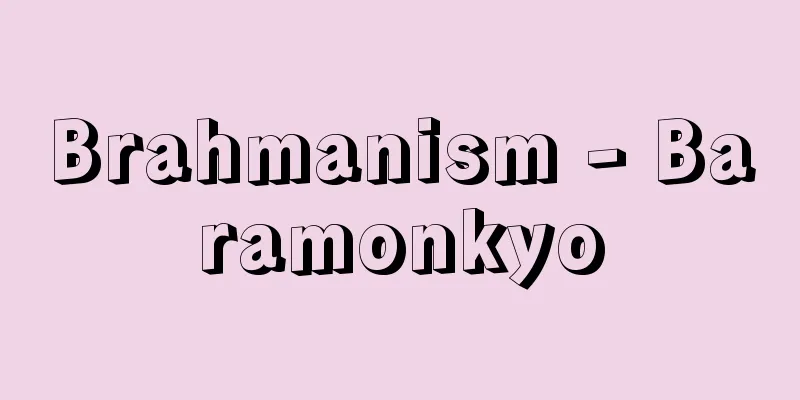Brahmanism - Baramonkyo

|
In ancient India, before the rise of Buddhism, a religion without a specific founder developed based on the Vedic scriptures, centered around the Brahmin class. It is called Brahmanism, a name given by Western scholars to distinguish it from so-called Hinduism, which was established around the 3rd century BC when Brahmanism absorbed various indigenous Indian elements and underwent a major transformation. Brahmanism is the Japanese translation of the term. Brahmanism forms the basis of Hinduism, and in the broad sense of the word Hinduism also includes Brahmanism. Around 1500 BC, the Indo-Aryans crossed the Hindu Kush Mountains from Afghanistan and entered the Punjab (Five Rivers) region of the Indus River basin, and then moved eastward to establish Brahmin culture in the fertile Doap region, where they developed a four-caste system (vara) with the Brahmin class at the top. When they entered India, they brought with them and developed the religion that they had long possessed, and between the time of their entry and around 500 BCE, they compiled the vast collection of fundamental scriptures, the Vedas, which include the Rig-Veda, Brahmanas, Aranyakas, and Upanishads. The content of the Upanishads is complex and diverse, but it includes everything from the worship of nature gods, religious rituals, and magic that they had held before their invasion to advanced philosophical speculation. The essence of their religion is polytheistic, but the search for the one fundamental principle of the universe, which began with the Rig Veda, reached its apex in the Upanishads, where Brahman (Brahman) was assumed to be the one fundamental principle of the universe, and Atman (self) was assumed to be the essence of individual existence, and the idea that the two are completely identical was finally expressed. The ideas of karma, reincarnation, and liberation established in the Upanishads not only became the core of Indian thought and culture, but also, along with Buddhism, have had a deep and wide-ranging influence on Asian peoples. Some of the Vedic gods, such as Taishakuten and Benzaiten, are worshiped in Japan. [Maeda College] [References] | | |Source: Shogakukan Encyclopedia Nipponica About Encyclopedia Nipponica Information | Legend |
|
古代インドにおいて、仏教興起以前に、バラモン階級を中心に、ベーダ聖典に基づいて発達した、特定の開祖をもたない宗教。およそ紀元前3世紀ころから、バラモン教がインド土着の諸要素を吸収して大きく変貌(へんぼう)して成立してくるいわゆるヒンドゥー教と区別するために西洋の学者が与えた呼称で、ブラフマニズムBrahmanismと称する。バラモン教(婆羅門教)はその邦訳語。バラモン教はヒンドゥー教の基盤をなしており、広義にヒンドゥー教という場合にはバラモン教をも含んでいる。前1500年ころを中心に、インド・アーリア人がアフガニスタンからヒンドゥー・クシ山脈を越えてインダス川流域のパンジャーブ(五河)地方に進入し、さらに東進して肥沃(ひよく)なドアープ地方を中心にバラモン文化を確立し、バラモン階級を頂点とする四階級からなる四姓制度(バルナvara)を発達させた。彼らはインドに進入する際、それ以前から長い間にわたって保持してきた宗教をインドにもちきたり、それを発展させ、進入時からおよそ前500年ころまでの間に、『リグ・ベーダ』をはじめ、ブラーフマナ、アーラニヤカ、ウパニシャッドを含む膨大な根本聖典ベーダを編纂(へんさん)した。 その内容は複雑多様であるが、彼らが進入以前から抱いていた自然神崇拝、宗教儀礼、呪術(じゅじゅつ)から高度な哲学的思弁までも包摂している。その宗教の本質は多神教であるが、『リグ・ベーダ』に端を発する宇宙の唯一の根本原理の探求はウパニシャッドにおいてその頂点に達し、宇宙の唯一の根本原理としてブラフマン(梵(ぼん))が、個人存在の本体としてアートマン(我(が))が想定され、ついには両者はまったく同一であるとする梵我一如の思想が表明されるに至った。またウパニシャッドで確立された業(ごう)・輪廻(りんね)・解脱(げだつ)の思想は、インドの思想・文化の中核となったばかりか、仏教とともにアジア諸民族に深く広い影響を与えている。ベーダの神々のなかには、帝釈天(たいしゃくてん)や弁才天のように日本で崇拝されているものもある。 [前田専學] [参照項目] | | |出典 小学館 日本大百科全書(ニッポニカ)日本大百科全書(ニッポニカ)について 情報 | 凡例 |
>>: Brahmin - Baramon (English spelling) Brāhmaa
Recommend
Napoleonic Wars
As the French Revolutionary Wars were waged by th...
Karakene (English spelling)
An ancient kingdom located at the mouth of the Tig...
Deferred assets and liabilities - Deferred asset, deferred liability
Although originally an expense or revenue, it is s...
Cuban Little Frog - Cuba Little Frog
... The genus Atelopus , which is a toad but has ...
Loch Ness - Loch Ness
A glacial lake in a tectonic valley that crosses n...
The town of Kakogan - Kakogan Town
…King's College was founded in 1494, and the ...
Saccostrea cucullata (English spelling)
…[Hiroshi Aramata]. … *Some of the terminology th...
Standard state - hyojunjoutai (English spelling) normal state
Generally, it refers to the state of a gas at a p...
Caron, A. (English spelling) CaronA
…After the sudden death of Rosso in 1540, a trend...
Grosses Festspielhaus, Salzburg (English) Grosses Festspielhaus Salzburg
…The new theater opened in 1908 (3,950 seats). Sa...
Yoshihisa Ashikaga
Born: November 23, 1465 in Kyoto [Died] March 26, ...
Market - Joshi
A type of market in Korea, it does not have any sp...
Kushigata [town] - Kushigata
A former town in Nakakoma County in western Yamana...
Color (fishing) - Color
...Fish jump around and spin around, and sometime...
rubella
What kind of disease is it? Main symptoms and cour...









